Blog & Latest Updates
Fly Fishing Articles
Insects by Common Name


Mayfly Species Epeorus vitreus (Sulphur)
Taxonomic Navigation -?-
Kingdom
Animalia (Animals)
» Phylum
Arthropoda (Arthropods)
» Class
Insecta (Insects)
» Order
Ephemeroptera (Mayflies)
» Genus
Epeorus (Little Maryatts)
» Species vitreus (Sulphur)
Common Names
This is page 2 of specimens of Epeorus vitreus. Visit the main Epeorus vitreus page for:
- The behavior and habitat of Epeorus vitreus.
Pictures of 15 Mayfly Specimens in the Species Epeorus vitreus:
Epeorus vitreus (Sulphur) Mayfly Nymph View 3 PicturesI suspect this is an Epeorus vitreus nymph. At the current instar (Instar: Many invertebrates molt through dozens of progressively larger and better-developed stages as they grow. Each of these stages is known as an instar. Hard-bodied nymphs typically molt through more instars than soft-bodied larvae.), it's tough to make out the pair of dots on the tergites (
View 3 PicturesI suspect this is an Epeorus vitreus nymph. At the current instar (Instar: Many invertebrates molt through dozens of progressively larger and better-developed stages as they grow. Each of these stages is known as an instar. Hard-bodied nymphs typically molt through more instars than soft-bodied larvae.), it's tough to make out the pair of dots on the tergites (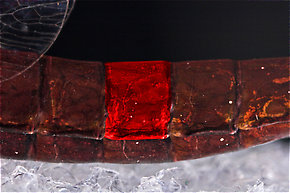 Tergite: The top (dorsal) part of a single segment on an insect's abdomen when it consists of a single chitinous plate (sclerite), or an individual sclerite if the segment has more than one.) which signify that species, but with zooming and contrast enhancement they become evident.
Tergite: The top (dorsal) part of a single segment on an insect's abdomen when it consists of a single chitinous plate (sclerite), or an individual sclerite if the segment has more than one.) which signify that species, but with zooming and contrast enhancement they become evident.
 View 3 PicturesI suspect this is an Epeorus vitreus nymph. At the current instar (Instar: Many invertebrates molt through dozens of progressively larger and better-developed stages as they grow. Each of these stages is known as an instar. Hard-bodied nymphs typically molt through more instars than soft-bodied larvae.), it's tough to make out the pair of dots on the tergites (
View 3 PicturesI suspect this is an Epeorus vitreus nymph. At the current instar (Instar: Many invertebrates molt through dozens of progressively larger and better-developed stages as they grow. Each of these stages is known as an instar. Hard-bodied nymphs typically molt through more instars than soft-bodied larvae.), it's tough to make out the pair of dots on the tergites (
One tergite of this Isonychia bicolor mayfly spinner is highlighted in red.
Collected January 13, 2004 from the Namekagon River in Wisconsin
Added to Troutnut.com by Troutnut on January 25, 2006
Added to Troutnut.com by Troutnut on January 25, 2006
Male Epeorus vitreus (Sulphur) Mayfly Spinner View 4 Pictures
View 4 Pictures
 View 4 Pictures
View 4 PicturesCollected May 26, 2007 from Penn's Creek in Pennsylvania
Added to Troutnut.com by Troutnut on June 4, 2007
Added to Troutnut.com by Troutnut on June 4, 2007
Epeorus vitreus (Sulphur) Mayfly Nymph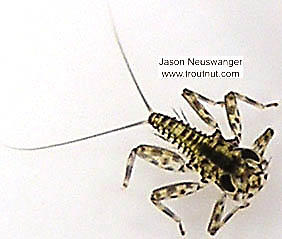 View 3 PicturesKey features I discerned with a microscope include that the femoral flange is sharp, and the first gill is not extended.
View 3 PicturesKey features I discerned with a microscope include that the femoral flange is sharp, and the first gill is not extended.
 View 3 PicturesKey features I discerned with a microscope include that the femoral flange is sharp, and the first gill is not extended.
View 3 PicturesKey features I discerned with a microscope include that the femoral flange is sharp, and the first gill is not extended.Collected February 7, 2004 from unknown in Wisconsin
Added to Troutnut.com by Troutnut on January 25, 2006
Added to Troutnut.com by Troutnut on January 25, 2006
Male Epeorus vitreus (Sulphur) Mayfly Dun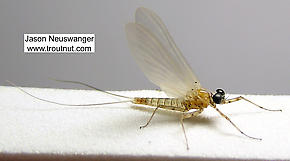 View 4 PicturesThis is my favorite mayfly from 2004, and it appears on my popular Be the Trout: Eat Mayflies products. Check them out!
View 4 PicturesThis is my favorite mayfly from 2004, and it appears on my popular Be the Trout: Eat Mayflies products. Check them out!
Its identification is really up in the air. It might be a late-season vitreus dun but it may very well be one of the more obscure species in that genus.
 View 4 PicturesThis is my favorite mayfly from 2004, and it appears on my popular Be the Trout: Eat Mayflies products. Check them out!
View 4 PicturesThis is my favorite mayfly from 2004, and it appears on my popular Be the Trout: Eat Mayflies products. Check them out!Its identification is really up in the air. It might be a late-season vitreus dun but it may very well be one of the more obscure species in that genus.
Collected September 2, 2004 from the Beaverkill River in New York
Added to Troutnut.com by Troutnut on January 25, 2006
Added to Troutnut.com by Troutnut on January 25, 2006
Epeorus vitreus (Sulphur) Mayfly Nymph View 3 PicturesKey features I discerned with a microscope include that the femoral flange is blunt (later note: on nymphs of this size, it's somewhat ambiguous and the femora (
View 3 PicturesKey features I discerned with a microscope include that the femoral flange is blunt (later note: on nymphs of this size, it's somewhat ambiguous and the femora ( Femur: The main segment of an insect's leg close to the body, in between the tibia and the trochanter.) can be damaged in the collection process), the postero-lateral (Lateral: To the side.) spines have a longer anterior (Anterior: Toward the front of an organism's body. The phrase "anterior to" means "in front of."), the first gill is not extended, all gills are tracheated, and the femora (
Femur: The main segment of an insect's leg close to the body, in between the tibia and the trochanter.) can be damaged in the collection process), the postero-lateral (Lateral: To the side.) spines have a longer anterior (Anterior: Toward the front of an organism's body. The phrase "anterior to" means "in front of."), the first gill is not extended, all gills are tracheated, and the femora ( Femur: The main segment of an insect's leg close to the body, in between the tibia and the trochanter.) have a distinctive brown spot on the center while all the other spots are gray.
Femur: The main segment of an insect's leg close to the body, in between the tibia and the trochanter.) have a distinctive brown spot on the center while all the other spots are gray.
 View 3 PicturesKey features I discerned with a microscope include that the femoral flange is blunt (later note: on nymphs of this size, it's somewhat ambiguous and the femora (
View 3 PicturesKey features I discerned with a microscope include that the femoral flange is blunt (later note: on nymphs of this size, it's somewhat ambiguous and the femora (
The femur of this Isonychia bicolor mayfly spinner is highlighted in red.

The femur of this Isonychia bicolor mayfly spinner is highlighted in red.
Collected February 7, 2004 from unknown in Wisconsin
Added to Troutnut.com by Troutnut on January 25, 2006
Added to Troutnut.com by Troutnut on January 25, 2006
Epeorus vitreus (Sulphur) Mayfly Nymph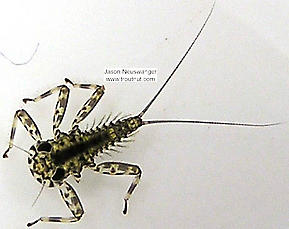 View 2 Pictures
View 2 Pictures
 View 2 Pictures
View 2 PicturesCollected February 7, 2004 from unknown in Wisconsin
Added to Troutnut.com by Troutnut on January 25, 2006
Added to Troutnut.com by Troutnut on January 25, 2006
Epeorus vitreus (Sulphur) Mayfly Nymph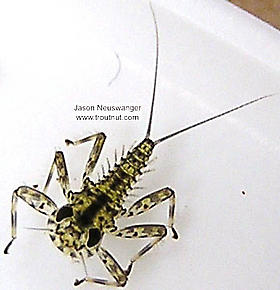 View 2 PicturesKey features I discerned with a microscope include that the femoral flange is blunt (again, given the other features and location, I probably misread this one), postero-lateral (Lateral: To the side.) spines with the anterior (Anterior: Toward the front of an organism's body. The phrase "anterior to" means "in front of.") longer, and the first gill is not extended.
View 2 PicturesKey features I discerned with a microscope include that the femoral flange is blunt (again, given the other features and location, I probably misread this one), postero-lateral (Lateral: To the side.) spines with the anterior (Anterior: Toward the front of an organism's body. The phrase "anterior to" means "in front of.") longer, and the first gill is not extended.
 View 2 PicturesKey features I discerned with a microscope include that the femoral flange is blunt (again, given the other features and location, I probably misread this one), postero-lateral (Lateral: To the side.) spines with the anterior (Anterior: Toward the front of an organism's body. The phrase "anterior to" means "in front of.") longer, and the first gill is not extended.
View 2 PicturesKey features I discerned with a microscope include that the femoral flange is blunt (again, given the other features and location, I probably misread this one), postero-lateral (Lateral: To the side.) spines with the anterior (Anterior: Toward the front of an organism's body. The phrase "anterior to" means "in front of.") longer, and the first gill is not extended.Collected February 7, 2004 from unknown in Wisconsin
Added to Troutnut.com by Troutnut on January 25, 2006
Added to Troutnut.com by Troutnut on January 25, 2006
Epeorus vitreus (Sulphur) Mayfly Nymph View 2 Pictures
View 2 Pictures
 View 2 Pictures
View 2 PicturesCollected February 7, 2004 from unknown in Wisconsin
Added to Troutnut.com by Troutnut on January 25, 2006
Added to Troutnut.com by Troutnut on January 25, 2006
Female Epeorus vitreus (Sulphur) Mayfly Dun View 6 Pictures
View 6 Pictures
 View 6 Pictures
View 6 PicturesCollected May 28, 2005 from the Namekagon River in Wisconsin
Added to Troutnut.com by Troutnut on May 24, 2006
Added to Troutnut.com by Troutnut on May 24, 2006
Female Epeorus vitreus (Sulphur) Mayfly Dun View 4 Pictures
View 4 Pictures
 View 4 Pictures
View 4 PicturesCollected June 8, 2005 from the Namekagon River in Wisconsin
Added to Troutnut.com by Troutnut on May 26, 2006
Added to Troutnut.com by Troutnut on May 26, 2006
Top 10 Fly Hatches
Top Gift Shop Designs
Eat mayflies.
Top Insect Specimens
Miscellaneous Sites
Troutnut.com is copyright © 2004-2024 Jason
Neuswanger (email Jason). See my FAQ for information about use of my images.
 privacy policy
privacy policy
